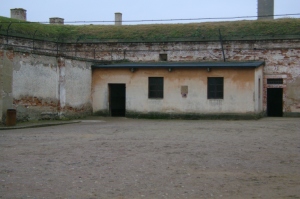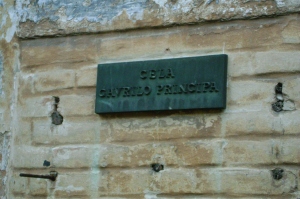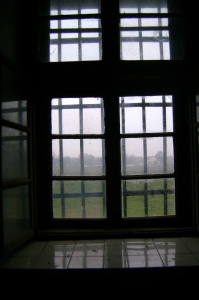 We had an appropriately gloomy day for our trip to the WWII Jewish Ghetto. A bus picked us up at our hotel and took us to the tour offices. Several tours were scheduled to start at the same time so for a while there was a large group of miscellaneous tourists standing around before we were divided into language and tour destination groups and loaded onto buses. As we waited my travel companion and I fell into conversation with the lone gentleman who was also at our hotel, but we discovered later, not on our tour. Turned out he works as a recruiter for Sprite in Texas. My travel companion’s husband will be looking for work in a few months. Texas is at the top of their short list for destinations. The recruiter then asked ‘would you be willing to live in Dallas though?’ Apparently, this is a sticking point. My companion and her husband are perfectly okay with it though. At that point the tour company finally had their act together and started separating us onto buses so I encouraged her to chase him down before he got away and get his info, which she did. Twenty-first century job hunting at its best.
We had an appropriately gloomy day for our trip to the WWII Jewish Ghetto. A bus picked us up at our hotel and took us to the tour offices. Several tours were scheduled to start at the same time so for a while there was a large group of miscellaneous tourists standing around before we were divided into language and tour destination groups and loaded onto buses. As we waited my travel companion and I fell into conversation with the lone gentleman who was also at our hotel, but we discovered later, not on our tour. Turned out he works as a recruiter for Sprite in Texas. My travel companion’s husband will be looking for work in a few months. Texas is at the top of their short list for destinations. The recruiter then asked ‘would you be willing to live in Dallas though?’ Apparently, this is a sticking point. My companion and her husband are perfectly okay with it though. At that point the tour company finally had their act together and started separating us onto buses so I encouraged her to chase him down before he got away and get his info, which she did. Twenty-first century job hunting at its best.
Terezin is an hour outside of the city. Add to that, the bus driver didn’t really know how to get there. We took a circuitous route through Praha 2 before heading out of the city in the correct direction. We passed the location where Heinrich Reinhardt, father of the Final Solution, was assassinated by three members of the Czech Resistance. We also passed some Soviet apartment blocks. Uglier than advertised.
The first stop at Terezin was the Jewish Cemetery. This is not an extermination camp, but overcrowding, overwork and malnutrition will do the job without the use of harsh chemicals. First, they were burying bodies. Then they built a crematorium and put the ashes in wooden urns. Then they couldn’t make urns fast enough so they started using “paper urns.” The only image that came to mind was a manila envelope, but one hopes not. The mortuary was locked because of the season so we didn’t get to go inside.
The second stop was the ‘little fortress.’ Terezin was originally built as a fortress for the Franco-Prussian Wars, but the wars were finished before the fortress was so the Hapsburgs used it as a political prison. That certainly made it easy for the Nazis to retrofit when they started moving their own political prisoners in. Our guide had an uncle (or possibly great uncle) who was a prisoner there. He died from the brutal treatment. Her aunt, arrested at the same time, got off comparatively easy. She was taken to Berlin where she was tried and executed. The first commandant the Nazis installed wasn’t a bad guy. He and his wife smuggled in messages for the prisoners, tried to get them decent food and didn’t allow random cruelty. At the end of the war when he was tried, he was let go without punishment. But the Nazis got wind that he wasn’t a sadist and replaced him with someone who was. This second commandant was sort of a genius for cruelty. One of the things he liked to do was save up the prisoners care packages and let them have a feast. Sounds good so far, right? Well, for this feast everything in the care packages was dumped into a big pot and cooked together. Meats, chocolate, pencils, cigarettes, sewing needles. Yum. Another of his food based punishments was to starve the prisoners (moreso) for a couple of days and then give them huge portions of over salted, over spiced food which they were required to eat all of.
stop was the ‘little fortress.’ Terezin was originally built as a fortress for the Franco-Prussian Wars, but the wars were finished before the fortress was so the Hapsburgs used it as a political prison. That certainly made it easy for the Nazis to retrofit when they started moving their own political prisoners in. Our guide had an uncle (or possibly great uncle) who was a prisoner there. He died from the brutal treatment. Her aunt, arrested at the same time, got off comparatively easy. She was taken to Berlin where she was tried and executed. The first commandant the Nazis installed wasn’t a bad guy. He and his wife smuggled in messages for the prisoners, tried to get them decent food and didn’t allow random cruelty. At the end of the war when he was tried, he was let go without punishment. But the Nazis got wind that he wasn’t a sadist and replaced him with someone who was. This second commandant was sort of a genius for cruelty. One of the things he liked to do was save up the prisoners care packages and let them have a feast. Sounds good so far, right? Well, for this feast everything in the care packages was dumped into a big pot and cooked together. Meats, chocolate, pencils, cigarettes, sewing needles. Yum. Another of his food based punishments was to starve the prisoners (moreso) for a couple of days and then give them huge portions of over salted, over spiced food which they were required to eat all of.
 One of the more famous residents of Terezin was Gavrilo Princip, the man who assassinated Archduke Franz Ferdinand of Austira, sparking World War I.
One of the more famous residents of Terezin was Gavrilo Princip, the man who assassinated Archduke Franz Ferdinand of Austira, sparking World War I.
Third stop was a museum housed in what was originally a school and, after the town was taken over and turned into a ghetto, a boys dorm. The first floor was devoted to the children, which was just crippling. Drawings and poems with the birth dates and usually death dates of the creators. None of then more than 14.
The last stop was a different museum that had more art and a replica of a barracks room, which for some inexplicable reason we were not allowed to take pictures of. I say inexplicable because we had just been in the real thing complete with unevenly worn floors and that cubical with the hole in the floor that served as a toilet for all several hundred people crammed in there. So what did this one have over the real thing? Set dressing. The second floor I could have spent hours looking at the drawings alone. These artists were professional artists before the war and they were astonishingly good at portraying more than just a snapshot of life in the ghetto.
This last photo I took because I thought it was one of the more cruel punishments. It’s the view of the town from the shower room. Impossibly close and impossibly unreachable.
Then it was an hour’s ride home. My companion and I decided to stop for dinner in Wenceslaus Square. The first place we stopped was too expensive, but further down the road and inside a gallery we found a place with the most divine ribs. While we were eating this guy came in. He overheard us talking and asked if we were in banking. Turns out he came to Prague to teach and is now in real estate management. Excellent source of information should we end up moving here.
